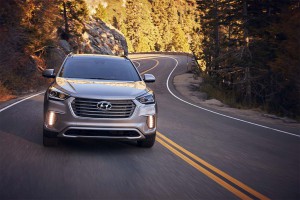
Sport-utility vehicles, like the Hyundai Sante Fe, dominated sales in 2017. The maker's lack of utes crimped its 2017 profits.
Hyundai Motor reported that its Q4 revenue of $23 billion and earnings were $970 million, or just a 3% increase, which was lower than the company predicted. Its full-year earnings were just $3.8 billion, a 25% drop and its worst result in eight years.
The South Korean automaker noted that it was hurt by overseas sales, particularly in China. The two countries are in the midst of a standoff over South Korea’s deployment of a missile defense system. The country’s use of the system is in response to North Korea’s ongoing display of missile launches.
The automaker sold 4.5 million vehicles in 2017, which is a 6% from last year. The drop is all from its non-domestic sales, which fell 8%. While last year was difficult, this year is likely to be worse at the company predicts its sales will fall to their lowest levels since 2008.
Hyundai is scrambling to play catch up in its largest markets outside of South Korea: North America and China. Larger sport-utility vehicles and crossovers have dominated U.S. sales for the last four years and Hyundai is only now filling those gaps in its product line-up.
(Hyundai hitting market with autonomous fuel cell vehicle this year. Click Here for the story.)
There are two utes in the current Hyundai line-up, including the smaller Tucson. But with utility vehicles now accounting for half of U.S. new car sales, and a growing share of the global market, the Korean company will be expanding its mix over the next several years, starting with the new Kona electric model.
It’s even working up a production version of the compact Santa Cruz pickup that was a hit, in concept form, at the Detroit Auto Show a few years back.
(Click Here for more about Hyundai’s new Veloster and Veloster N.)
But the Santa Fe is a critical offering and needs a major refresh. The image here appears to be of the standard version of the ute, rather than the smaller Santa Fe Sport model.
Visually, the teaser suggests the 2019 Santa Fe might grow ever so slightly, especially in light of some reports from Korea. That has included talk of a new rear bench that would expand seating to eight from the current seven.
(To see more about Hyundai partnering with Google self-driving guru Chris Urmson, Click Here.)
Last year, the company spent big money marketing its Genesis luxury brand as a stand-alone unit and the launch of the Kona, its first subcompact SUV. South Korean exporters like Hyundai Motor face another challenge this year: the strengthening of the South Korean won, and other major currencies, against the U.S. dollar.

Hyundai must have poached a few Product Planners from Ford.